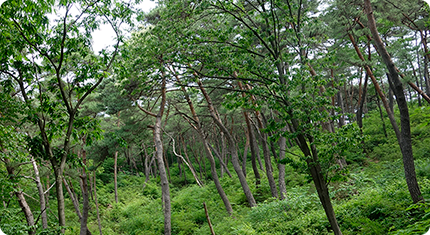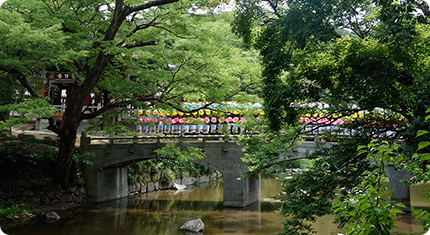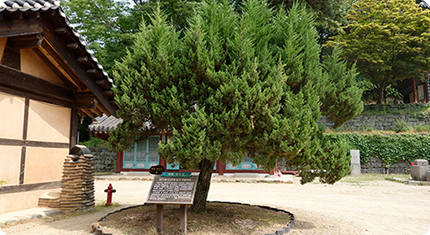Buddhist Mountain Monasteries in Korea
Magoksa Temple
Magoksa Temple
Introduction
Natural Environment
History
Temple Layout
Cultural Properties
Information
Natural Environment of Taehwasan Mountain
-
-
 Pine tree forest behind Daeungbojeon
Pine tree forest behind Daeungbojeon
- Taehwasan Mountain (423m) is situated between Sagok-myeon, Sinpung-myeon and Yugu-myeon of Gongju-si in Chungcheongnam-do Province. The geographical name, Taehwasan, was initially used in Sajeok-iban compiled in the late Joseon period. On the other hand, in Dongguk-yeoji-seungnam (Survey of the Geography of Korea) and Taengniji, Magoksa Temple is said to be based on “Museongsan Mountain.” However, there is a stream called, Myeonggacheon, flowing between Magoksa and the present-day Museongsan; thus, it is difficult to find a geographical association between them. At present, the mountains surrounding Magoksa Temple like a basin are called Taehwasan, which is comprised of Guksabong Peak (591m) on the north, Ongnyeobong (362m) on the west and Museongsan (614m) on the east. At the peak of the mountain, one can enjoy a magnificent view of the surroundings including Museongsan Mountain on the east side, Gyeryongsan Mountain and Gongju City on the southeast side, and Chilgapsan Mountain on the west. Also, Sangwon Falls on the hillside and the spring located near Hwarinbong Peak are famous.
-
-
- The forests of Taehwasan Mountain are mostly comprised of conifers and oak trees.
There are forests of old pine trees, along the ridges and around the temple, and rows of cherry trees along Taehwacheon Stream that present a beautiful sight alongside the new sprouts every spring. For this reason, it has been described as “chun-magok-chu-gapsa,” meaning a temple of spring and autumn, to note its breathtaking scenery, especially in those two seasons. Of particular note, along the 5km hiking trail that passes through Hwarinbong and Nabalbong peaks and winds around Magoksa Temple, there are dense forests of red pine trees that are hundreds of years old. -
 Geungnakgyo Bridge of Magoksa Temple
Geungnakgyo Bridge of Magoksa Temple
- The forests of Taehwasan Mountain are mostly comprised of conifers and oak trees.
-
- The most notable trees found at Magoksa Temple include the juniper that is associated with Baekbeom Kim Gu. After retiring as an independence fighter, Kim Gu temporarily joined the monastic order under the Dharma name, Wonjong, in 1898, and stayed at the Baenyeonam hermitage. In 1946, following the liberation of Korea from the Japanese colonial rule, Kim Gu is said to have visited Magoksa and planted a rose of Sharon tree and a juniper, of which only the juniper growing between Daeungbojeon and Eungjinjeon remains today. Also, there is a legend regarding a “bush clover” pillar of Daeungbojeon of Magoksa that was, in fact, made from a zelkova tree. Today, a large number of old zelkova trees can be seen growing in and around the temple site. To note, zelkovas do not rot easily and have a long life span, and this is why it has been used frequently to build pillars for wooden structures and buildings in the past in Korea.
-
 Juniper planted by Kim Gu
Juniper planted by Kim Gu
